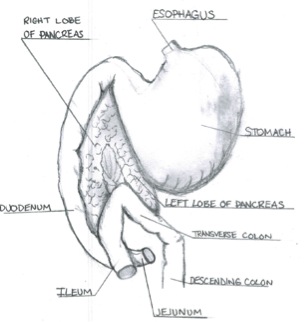As veterinarians, we strive to be educators. However, not having gone to teachers’ college, our skills have only been picked up through our roles as students. This is sometimes reflected in the ways we address clients when we put on our teaching caps. The other day, one of our staff members mentioned to me that lately there seemed to be a lot of pancreatitis cases paired with a lot of confused owners. “Pancrea-what”? I must admit, even my first year out of vet school, I was still confused with this disease. So for all of you confused owners out there, I apologize and hopefully what you are about to read will clear up any previous misconceptions about this disease.
What is the pancreas?
The pancreas seems to be one of those forgotten organs. Everyone has one but beats me if you can tell me what it does. The pancreas has a multitude of functions but the one we are concerned about with pancreatitis is its role in digestion. When we eat, we swallow food and the digestive process begins. Food breaks down when it enters the stomach via the esophagus. Immediately after the stomach, it begins its topsy turvy descent through the small intestine for further digestion and nutrient absorption. Nestled between the stomach and the small intestine is the pancreas. The pancreas has a couple of functions, but the major one that is of concern with pancreatitis, is the secretion of enzymes which help to further break down food particles.
What happens during an episode of pancreatitis?
“-Itis” in medical lingo generally means inflammation; hence pancreatitis is inflammation of the pancreas. During an episode of pancreatitis, inflammation hinders the regular digestive functions of the pancreas. This can further lead to damage of the pancreas and lead to neighboring organs, like the liver and small intestine, being affected. This domino effect of tissue damage has the potential to spread through the entire body and wreak havoc.
Dogs vs. Cats
As you may suspect, pancreatitis can be extremely painful. Interestingly, there are some differences in the symptoms that dogs and cats exhibit. In Fido, we will often see a dog with little appetite who is vomiting, having diarrhea, has a painful belly, and may have a fever. Fluffy, on the other hand, may have decreased energy and appetite, but rarely will have nausea or abdominal pain.
Diagnosing and treating pancreatitis
Unfortunately the most common cause of pancreatitis is idiopathic, meaning us vets are dare we say too ‘idiotic’ to figure out the root causeJ Sometimes, however, animals will get pancreatitis from what I will refer to as “overindulgence of the holiday season”. By this I mean a sudden fatty meal; something commonly seen when Rover decides to get into the Christmas gravy or snatch a burger from the local neighborhood barbeque.
Pancreatitis comes in all shapes and sizes. Some cases are mild and some can be quite severe. It is important that if your pet exhibits any of the signs above, that he or she see us right away. To diagnose pancreatitis, bloodwork is necessary. Depending on the severity of the case, further diagnostics may be necessary. How your cat or dog does in the long run depends on the severity of his or her illness. While some animals can be treated at home with medication, others may require a prolonged hospital visit. For some, a life change may be necessary, consisting of strict diet and lifelong medications and monitoring.
Moral of the story
Pancreatitis is serious business. Perhaps one of the reasons people find it so confusing is because every case is different and there is not one specific antidote. Regardless, my hope is that I, your fearless educator, have instilled some knowledge and not confused you farther. If nothing else, you can now recognize the potential signs of an animal with pancreatitis and will hopefully think twice when considering feeding your pet the leftover holiday delicacies.



